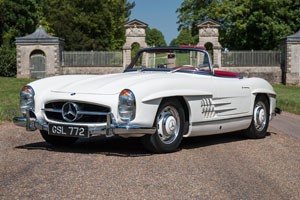ONE OF THE THINGS that pushes up the value of classic cars is their investment potential, and while this pushes many of them out of the reach of genuine enthusiasts, it’s a fact of life.
Another unintended consequence is that the value of a car collection can grow quite significantly and tie up a lot of capital.
London-based financier JBR Capital is seeing a new trend in the UK as owners use the equity in their rapidly appreciating automotive assets.
In a plan similar to a reverse mortgage, owners are able to “sell” their vehicle to a lender and then hire purchase it back. The process, known as “sale and hire purchase” is useful to owners who don’t wish to sell but want to realise the capital in their cars.
According to JBR Capital, such deals in the UK increased by 54 percent in 2018. JBR reported that one owner was able to release the equity in his collection of classic Ferraris to free up cash for a property investment.
Such a scheme, if available in Australia, would overcome one of the criticisms of classic cars as an investment that they are an asset difficult to convert into ready cash should the need arise.

The availability of a “sale and hire purchase” scheme in Australia would raise a number of issues, including taxation, asset appreciation, capital gains and numerous others.
Here at seniordriveraus we are philosophically against treating motor cars as investments – they become too expensive to use as the maker intended; real enthusiasts quickly find desirable cars priced out of their reach; insurance premiums inevitably increase; and far too many non-enthusiasts end up owning cars for which they have no appreciation. One other consequence is that many naïve owners end up buying cars that are not as they have been represented (fakes and replicas) and certainly worth far less than was paid for them.
Another issue is the number of cars bought as investments by self-managed superannuation funds. According to the rules of an SMSF, assets held by the fund are not for the use of the fund holder. In other words, a car owned by an SMSF is, by definition, not meant to be driven.
Specifically, the SMSF rules state that a classic car must be purchased and held in accordance with the superannuation legislation.
- They cannot be purchased from a related party.
- Such an investment must be allowed by the trust fund deed.
- The car must not be leased to any related party of the SMSF. It must not be stored or displayed in the private residence of any related party of the SMSF (although it can be stored but not displayed in business premises).
- The trustees must record in writing the reasons for the decision on where to store the car and keep that record for 10 years.
- The trustees must ensure the asset is insured in the name of the fund within seven days of acquisition.
- The classic car can not be used by any related party of the SMSF.
- If the classic car is sold or transferred from the SMSF to a related party of the fund, it must be done at a market price determined by a qualified independent valuer.
Note that point about driving the classic car. In no circumstance, even for maintenance purposes, to show for sale purposes or to have restoration work done, can the car be driven by a related party. However, a person who is not a related party is allowed to drive the vehicle for such purposes.

A “related party” includes all members of the fund, relatives of each member, business partners of each member, spouse or child of any business partners, any company the member or their associates control or influence, any trust the member or their associates control. Also considered related parties are standard employer-sponsors who contribute to the super fund for the benefit of a member under an arrangement between the employer and a trustee of the fund and associates of standard employer-sponsors such as business partners and companies or trusts the employer control (either alone or with other associates) and companies and trusts that control the employer.

Like all things related to taxation, releasing the equity in a classic car is a complicated issue and requires professional advice. If you own a car in the name of your SMSF and are using it, you are in breach of the rules and need to reconsider your actions.
